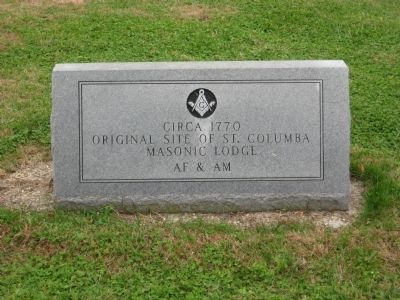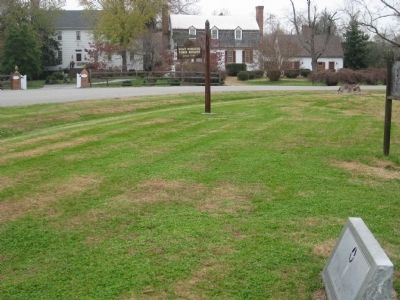Port Tobacco in Charles County, Maryland — The American Northeast (Mid-Atlantic)
St. Columba Masonic Lodge
Original site of St. Columba Masonic Lodge
AF & AM
Topics. This historical marker is listed in these topic lists: Colonial Era • Fraternal or Sororal Organizations. A significant historical year for this entry is 1770.
Location. 38° 30.665′ N, 77° 1.178′ W. Marker is in Port Tobacco, Maryland, in Charles County. Marker can be reached from Chapel Point Road, 0.4 miles south of Port Tobacco Road (Maryland Route 6). Marker is on the lawn between Chapel Point Road and the entrance to the Port Tobacco courthouse. Touch for map. Marker is in this post office area: Port Tobacco MD 20677, United States of America. Touch for directions.
Other nearby markers. At least 8 other markers are within walking distance of this marker. John Wilkes Booth (within shouting distance of this marker); Port Tobacco (within shouting distance of this marker); On to Yorktown (within shouting distance of this marker); Port Tobacco: Commerce (within shouting distance of this marker); Port Tobacco: Conspiracy & the Plot to Assassinate President Lincoln (within shouting distance of this marker); Port Tobacco: A Maryland Mosaic (within shouting distance of this marker); The Port Tobacco Jail (about 400 feet away, measured in a direct line); a different marker also named Port Tobacco (approx. 0.4 miles away). Touch for a list and map of all markers in Port Tobacco.
Regarding St. Columba Masonic Lodge. The following was copied from http://porttobacco.blogspot.com/2007_12_09_archive.html.
Port Tobacco was more than a collection of homes and businesses. It had a variety of institutions on which the people built a community, including churches and schools, most of which were racially segregated. One of those institutions was the Masonic Lodge about which we have been able to get some information from Edward Schultz’s 1884 history of the Craft in Maryland.
In 1792, a number of members of the George Town Lodge No. 9 (in present day Washington, DC) petitioned to create a branch lodge in Port Tobacco, to which they had moved. They received a charter from the Grand Lodge of Maryland and sustained St. Columba Lodge No. 10 at least until 1798.
Schultz noted that the proceedings of the Lodge were full and well-kept, and that they included the names, occupations, and residences of initiates. He published the names, which appear below.
A number of St. Columba members, because of the distance of the Lodge from their respective homes, similarly petitioned to create Hiram Lodge No. 27 in Leonard Town, St. Mary’s County, in 1798, which was chartered that year. St. Columba may have disbanded shortly thereafter, as did Hiram.
Ironically, a Lodge existed in Leonard Town between 1759 and 1764. The surviving proceedings for the Lodge include the following
entry dated November 4, 1761: “Ordered also that Brother [Ebenezer] Fisher write to Mr. James Mills for the Jewells belonging to the Portobacco Lodge which are now in the possession of the said Mills.” In short, one of the earliest Lodges in Maryland, and in the colonies, had formed in Port Tobacco by 1760, disbanded with members going to George Town and Leonard Town, then revived in 1792 only to disband again with at least some members reviving the Leonard Town Lodge.
Apart from celebrating the feast days of St. John the Baptist (June 24) and St. John the Evangelist (December 27), often with a church service followed by a dinner and ball, it isn’t clear what these Lodges did. Likely they were very different in some respects from Masonic Lodges of the present. Certainly they helped cement good relations among competing merchants, and also between the native born, largely English planters, and the newly arrived Scots merchants.
Credits. This page was last revised on January 5, 2020. It was originally submitted on November 15, 2009, by F. Robby of Baltimore, Maryland. This page has been viewed 1,342 times since then and 13 times this year. Photos: 1, 2. submitted on November 15, 2009, by F. Robby of Baltimore, Maryland.

